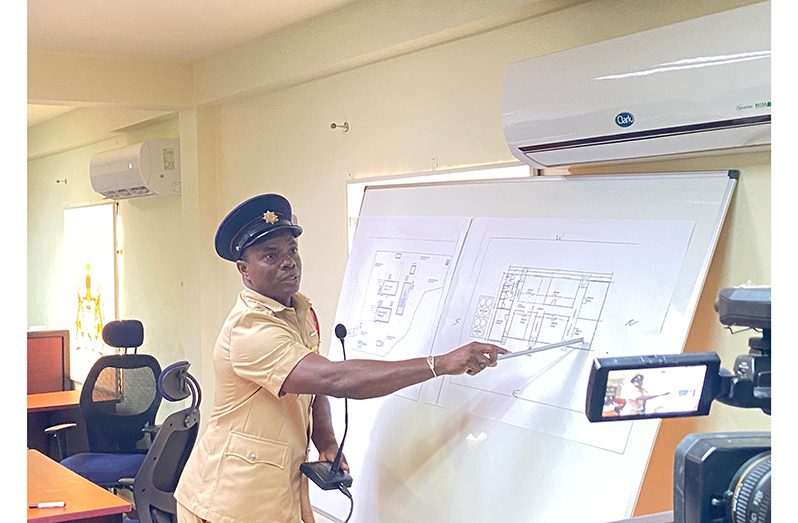CoI hears
THREE months prior to the deadly Mahdia dormitory fire which claimed the lives of 20 children, several recommendations were made by the Sub-Officer attached to the Guyana Fire Service, following an inspection of the dorms in Mahdia.
|
This was revealed on Wednesday during the fourth day of the Presidential Commission of Inquiry into the Mahdia fire when Sub-officer Ryan Scott, who is attached to the Guyana Fire Service and serves as the officer in Charge at the Mahdia Fire Station presented his testimony.
According to Scott, he was alerted to the fire on May 21 after hearing the loud blowing of a horn signalling an emergency. Subsequently, he was alerted by someone that the dorm was on fire.
Immediately, he noted that he and the crew donned their Personal Protective Equipment (PPE) and proceeded to the scene of the fire.
As they were making their way to the scene, the Sub-Officer noted they encountered difficulties, which included the build-up of a crowd along the route, air in the vehicle and vehicles being parked along the roadway to the scene.
Upon arrival at the scene, he noted that the building was fully engulfed in flames while adding that red and blue flames were seen in various portions of the building.
He noted the need for at least five people to respond to the fire, but the Mahdia Fire Service was understaffed.
During that time, the Chairman of the Commission, Justice Ret’d, Joe Singh, inquired about the human resources needed at the Mahdia fire station.
Scott pointed out that, at the time, the Mahdia fire station, along with a few others, had not been commissioned, resulting in no fixed establishment for the number of people to be stationed there. As a result, the fire service did not receive a manpower increase to operate those stations.
ON THE SCENE
Scott proceeded to discuss his observations of the scene, noting that upon entering the dorm compound, they saw panicking individuals and a building on fire.
At that time, he said that about 80 per cent of the building was covered in red flames while another 10 per cent had blue flames.
He explained that red flames indicate the burning of normal combustible materials, while blue flames suggest electrical or flammable substances. Additionally, he mentioned that the building’s southern roof had already collapsed.
Scott elaborated on his course of action, which involved ensuring everyone’s safety. Upon discovering that 16 persons were located and around 40 were still unaccounted for, he decided to proceed with rescue efforts and extinguish the fire.
Upon learning that individuals were trapped in the building, he mentioned that a rapid scan of the premises was conducted to determine the most accessible area for rescue.
When a rescue path was finally made by breaking a wall, Scott realised their vehicle’s water supply had run out and the fire was still burning.
However, he clarified that he gave the on-board pump to auxiliary firefighters, who used it to extract water from a nearby trench, while he went to refill the tank and return to the scene.
Several hours later, he observed that they successfully put out the fire by pumping water from the nearby trench.|
INSPECTION AND RECOMMENDATIONS.
Meanwhile, Scott told the commission that he had inspected the dorm some months prior in February of this year.
During that time, he indicated that there was no placement of any fire extinguishers within the dorm or a fire hydrant around the vicinity of the dorm in Mahdia. However, when pressed by attorney Keoma Griffith as to whether it would be prudent for a hydrant to be placed in that vicinity where over 100 school children are housed, he noted that it was important for one to be there.
He pointed out that the absence of a hydrant in that area was due to a two-inch water main instead of the required four-inch one.
“On numerous occasion, it was brought to the Regional Democratic Council, REO’s attention, because there is the school dorms, the same army and the police headquarters it’s the same thing leading to that area, so we’re still unable to install hydrants in those areas,” Scott told the commission after he was asked if persons were informed of this.
Additionally, it was discovered that after the February inspection, it was noted that the buildings lacked fire alarm and fire detection systems, and all windows had grills.
Furthermore, it was observed that the building lacked exit signs and smoke detectors.
Several recommendations were made in that report to enhance dorm safety and fire preparedness. Certain suggestions proposed the installation of outward-opening exit doors and removal of grills.
He agreed that the absence of all these things was a threat to life and safety at the dorm even as he noted that the report was submitted to regional officials and further to the Guyana Fire Service as well.
During questioning, Scott informed the commission that the fire service was understaffed and lacking necessary equipment, working with a 12-year-old fire truck.
However, despite the shortcomings, Scott affirmed to the commission that the Guyana Fire Service did its best and was in a position to effectively respond to the fire.





.jpg)








